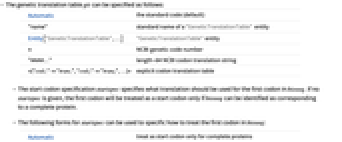BioSequenceTranslate[bioseq]
translates a DNA or RNA sequence bioseq to a peptide sequence.
BioSequenceTranslate[bioseq,gtt]
uses the genetic translation table gtt.
BioSequenceTranslate[bioseq,gtt,startspec]
treats start codons in bioseq according to the specification startspec.


BioSequenceTranslate
BioSequenceTranslate[bioseq]
translates a DNA or RNA sequence bioseq to a peptide sequence.
BioSequenceTranslate[bioseq,gtt]
uses the genetic translation table gtt.
BioSequenceTranslate[bioseq,gtt,startspec]
treats start codons in bioseq according to the specification startspec.
Details

- The genetic translation table gtt can be specified as follows:
-
Automatic the standard code (default) "name" standard name of a "GeneticTranslationTable" entity Entity["GeneticTranslationTable",…] "GeneticTranslationTable" entity n NCBI genetic code number "AAAA…" length-64 NCBI codon translation string <|"cod1""tran1","cod2""tran2",…|> explicit codon translation table - The start codon specification startspec specifies what translation should be used for the first codon in bioseq. If no startspec is given, the first codon will be treated as a start codon only if bioseq can be identified as corresponding to a complete protein.
- The following forms for startspec can be used to specific how to treat the first codon in bioseq:
-
Automatic treat as start codon only for complete proteins False never treat as start codon True always treat as start code - The following additional forms for startspec can be used to define start codon behavior, overriding the specification implied by the genetic translation table gtt:
-
n use NCBI genetic code number start codon specification "AAAA…" use length-64 NCBI start codon translation string <|"cod1""tran1","cod2""tran2",…|> explicit specify start codon translations
Examples
open all close allScope (8)
Translate using a "GeneticTranslationTable" entity:
Translate using the table corresponding to a NCBI genetic code number:
Use an Association to specify the translation table:
Use an arbitrary NCBI translation table:
Use the start translation of the automatically selected translation table:
Specify start codon translations with an association of the changed start codons:
Applications (2)
The translations to selenocysteine (U) and pyrrolysine (O) only happen in particular chemical contexts that are distinct from the translation system for a particular organism. One way to incorporate them is to change the codon translation association:
After splicing together coding sequences, translation yields the same sequence as the protein:
Possible Issues (2)
Inputs with degenerate letters may have multiple possible translations with no single generalization:
Using BioSequenceInstances first will avoid ambiguous results:
If the length of a DNA or RNA sequence is not a multiple of three, then the remaining letters after constructing codons are discarded from the end of the sequence:
See Also
BioSequence BioSequenceBackTranslateList BioSequenceTranscribe BioSequenceInstances
Entity Types: GeneticTranslationTable
Function Repository: NCBITranslationTableConvert
Related Guides
History
Text
Wolfram Research (2020), BioSequenceTranslate, Wolfram Language function, https://reference.wolfram.com/language/ref/BioSequenceTranslate.html.
CMS
Wolfram Language. 2020. "BioSequenceTranslate." Wolfram Language & System Documentation Center. Wolfram Research. https://reference.wolfram.com/language/ref/BioSequenceTranslate.html.
APA
Wolfram Language. (2020). BioSequenceTranslate. Wolfram Language & System Documentation Center. Retrieved from https://reference.wolfram.com/language/ref/BioSequenceTranslate.html
BibTeX
@misc{reference.wolfram_2025_biosequencetranslate, author="Wolfram Research", title="{BioSequenceTranslate}", year="2020", howpublished="\url{https://reference.wolfram.com/language/ref/BioSequenceTranslate.html}", note=[Accessed: 28-December-2025]}
BibLaTeX
@online{reference.wolfram_2025_biosequencetranslate, organization={Wolfram Research}, title={BioSequenceTranslate}, year={2020}, url={https://reference.wolfram.com/language/ref/BioSequenceTranslate.html}, note=[Accessed: 28-December-2025]}